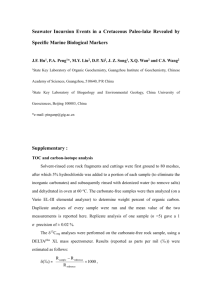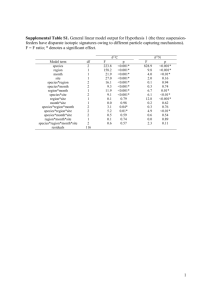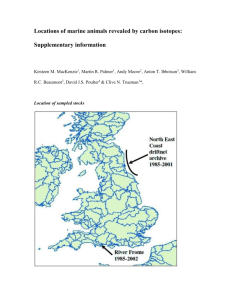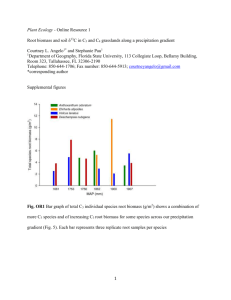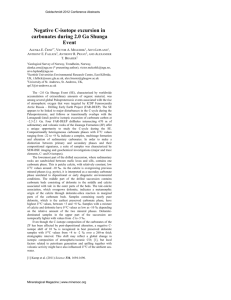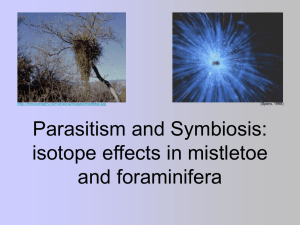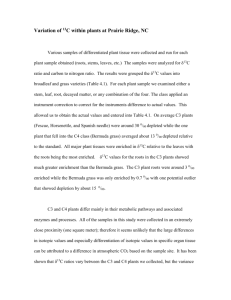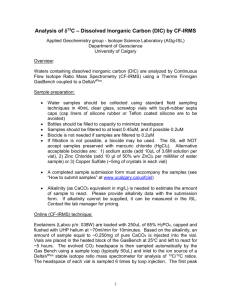Winners and losers in herbaceous plant communities:
advertisement
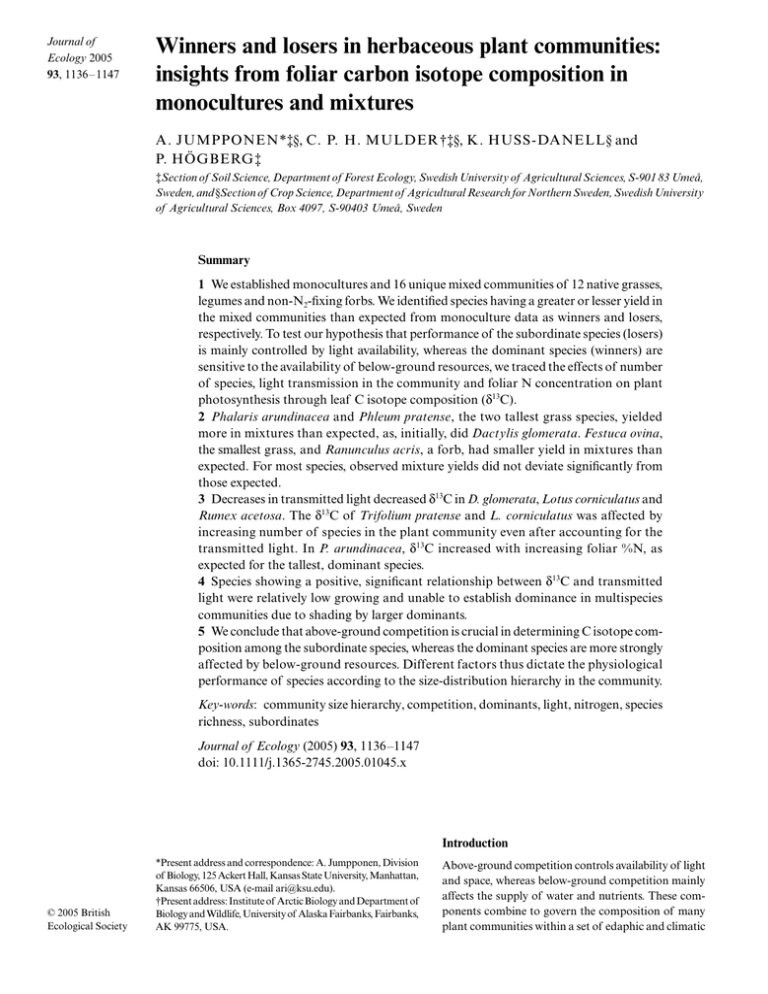
Journal of Ecology 2005 93, 1136– 1147 Winners and losers in herbaceous plant communities: insights from foliar carbon isotope composition in monocultures and mixtures Blackwell Publishing, Ltd. A. JUMPPONEN*‡§, C. P. H. MULDER†‡§, K. HUSS-DANELL§ and P. HÖGBERG‡ ‡Section of Soil Science, Department of Forest Ecology, Swedish University of Agricultural Sciences, S-901 83 Umeå, Sweden, and §Section of Crop Science, Department of Agricultural Research for Northern Sweden, Swedish University of Agricultural Sciences, Box 4097, S-90403 Umeå, Sweden Summary 1 We established monocultures and 16 unique mixed communities of 12 native grasses, legumes and non-N2-fixing forbs. We identified species having a greater or lesser yield in the mixed communities than expected from monoculture data as winners and losers, respectively. To test our hypothesis that performance of the subordinate species (losers) is mainly controlled by light availability, whereas the dominant species (winners) are sensitive to the availability of below-ground resources, we traced the effects of number of species, light transmission in the community and foliar N concentration on plant photosynthesis through leaf C isotope composition (δ13C). 2 Phalaris arundinacea and Phleum pratense, the two tallest grass species, yielded more in mixtures than expected, as, initially, did Dactylis glomerata. Festuca ovina, the smallest grass, and Ranunculus acris, a forb, had smaller yield in mixtures than expected. For most species, observed mixture yields did not deviate significantly from those expected. 3 Decreases in transmitted light decreased δ13C in D. glomerata, Lotus corniculatus and Rumex acetosa. The δ13C of Trifolium pratense and L. corniculatus was affected by increasing number of species in the plant community even after accounting for the transmitted light. In P. arundinacea, δ13C increased with increasing foliar %N, as expected for the tallest, dominant species. 4 Species showing a positive, significant relationship between δ13C and transmitted light were relatively low growing and unable to establish dominance in multispecies communities due to shading by larger dominants. 5 We conclude that above-ground competition is crucial in determining C isotope composition among the subordinate species, whereas the dominant species are more strongly affected by below-ground resources. Different factors thus dictate the physiological performance of species according to the size-distribution hierarchy in the community. Key-words: community size hierarchy, competition, dominants, light, nitrogen, species richness, subordinates Journal of Ecology (2005) 93, 1136–1147 doi: 10.1111/j.1365-2745.2005.01045.x Introduction © 2005 British Ecological Society *Present address and correspondence: A. Jumpponen, Division of Biology, 125 Ackert Hall, Kansas State University, Manhattan, Kansas 66506, USA (e-mail ari@ksu.edu). †Present address: Institute of Arctic Biology and Department of Biology and Wildlife, University of Alaska Fairbanks, Fairbanks, AK 99775, USA. Above-ground competition controls availability of light and space, whereas below-ground competition mainly affects the supply of water and nutrients. These components combine to govern the composition of many plant communities within a set of edaphic and climatic 1137 Herbaceous plant communities conditions (e.g. Gleason 1926; Connell 1983; Schoener 1983). However, the relative importance of above- and below-ground competition, as well as their operating mechanisms, is unclear, especially in complex, natural, multispecies communities (e.g. Thompson & Grime 1988; Aerts 1999; Tilman 1999). In diverse communities, only a few species establish a clear dominance and contribute a major proportion to the community biomass (dominants sensu Grime 1998): most species are less significant contributors (Mitchley & Grubb 1986; Mitchley 1988) and are classified as subordinates or transients. Dominant species tend, by the virtue of their size, to have a vast impact on their neighbouring plants as well as on ecosystem properties (Silvertown & Dale 1991; Grime 1998). Monoculture studies show that larger individuals may obtain a disproportionately large share of resources. For instance, interception of a unidirectional resource such as light may partially pre-empt the supply (leading to pre-emptive, asymmetric competition, or overproportional acquisition of resources, Weiner 1985, 1990; Weiner & Thomas 1986; Hikosaka et al. 1999). As a result, smaller individuals may be strongly affected by insufficient light, despite being able to fulfil their demand for non-directional resources such as nutrients, while larger individuals may suffer more from nutrient limitation because of their greater total demand. Such results may be extrapolated into multispecies communities. In monoculture, smaller individuals may experience intense intraspecific competition, whereas in mixed plant communities subordinate species experience a shift from intraspecific to interspecific competition, resulting in drastic shifts in resource availability. An integrated, long-term measure of photosynthetic activity is provided by the foliar stable C isotope composition, a function of the ratio of intercellular to ambient CO2 concentration (Ci/Ca) and the C isotopic composition of source CO2, δ13Csource (Farquhar et al. 1982, 1989). This can be approximated δ13Cplant = δ13Csource − 4.4 − 22.6(Ci/Ca) © 2005 British Ecological Society, Journal of Ecology 93, 1136–1147 where 4.4. is the isotopic fractionation against 13CO2 during diffusion in air and 22.6(Ci/Ca) is the fractionation during photosynthesis by Rubisco. The ratio Ci/ Ca is proximally controlled by stomatal aperture and, hence, by factors such as air humidity, as well as by the rate of photosynthesis, which depends on irradiation and plant nutrient status. The plant C isotope composition is thus influenced by a combination of intra(Geber & Dawson 1990; Schuster et al. 1992a; Zhang et al. 1993) and interspecific genetic factors (Smedley et al. 1991; Schuster et al. 1992b), as well as by a variety of environmental factors (Bender & Berge 1979; Ehleringer & Cooper 1988; Körner et al. 1991; Marshall & Zhang 1994). Importantly, levels of light (Ehleringer et al. 1986, 1987; Zimmerman & Ehleringer 1990) have been shown to affect plant stable C isotope composition. Similarly, increased N availability is likely to affect C isotope discrimination because C assimilation rate of a leaf is linearly related to its N concentration (Field & Mooney 1986; Evans 1989). Although the connections between both N and light availability and C isotope composition are well understood, little emphasis has been placed on studying these interactions in diverse plant communities. Declines in the foliar δ13C have occasionally been attributed to interspecific competition among co-occurring plants (Williams et al. 1991; Leffner & Caldwell 2005). Similarly, Schuster et al. (1992b) noted a negative correlation between C isotope discrimination and distance to closest neighbour from perennial shrubs, Larrea tridentata and Encelia farinosa, in desert communities, and related this pattern to competitive interactions. Caldeira et al. (2001) found lower δ13C in several plants when grown in mixtures as compared with monocultures. They proposed that this provided evidence of greater water-use efficiency in mixtures. Taken together, the C isotope composition in plants growing in multispecies communities is affected by both the abiotic (resource availability) and biotic (competitive interactions) environment the individual plants experience. In this study, we set up experimental plots comprised of 12 unique monocultures and 16 unique mixed plant communities with up to 12 species of grasses, legumes and non-nitrogen-fixing forbs. We first compared the observed yields in mixed plant communities with those expected based on the yields in monocultures. We thus identified species that were unaffected or tended to produce more (winners) or less (losers) than expected in mixed communities. We additionally used stable C isotope composition (δ13C), light interception data and the foliar N concentration of the individual species in these mixed plant communities to test the hypothesis that, in mixed plant communities, growth and performance of the subordinate species is limited by shading by the dominant species. Subordinate performance is therefore expected to be mainly controlled by light availability, whereas the dominant species are not directly affected by their above-ground neighbours but, rather, are sensitive to other limitations, such as nutrient availability. Accordingly, we predicted that subordinate species in mixed communities would have lower δ13C than when grown in monocultures, while δ13C in dominant plants would be more likely to correlate with foliar N concentrations. Materials and methods EXPERIMENTAL SET UP The research site is located on a several kilometre wide floodplain in Umeå, Sweden (63°45′ N, 20°17′ E, 12 m a.s.l.). Soil at the site contains 4% clay, 58% silt and 38% fine sand. The site was previously used for agricultural 1138 A. Jumpponen et al. © 2005 British Ecological Society, Journal of Ecology 93, 1136–1147 Table 1 Species mixtures created by random allocation, with the constraint that each species appeared in one monoculture, one two-, two four- and two eight-species mixtures Species in the mixture Two-species mixtures Dactylis glomerata, Phalaris arundinacea; Phleum pratense, Trifolium pratense; Leucanthemum vulgare, Lotus corniculatus; Achillea millefolium, Festuca ovina; Ranunculus acris, Rumex acetosa; Trifolium hybridum, Trifolium repens Four-species mixtures Lotus corniculatus, Phalaris arundinacea, Phleum pratense, Trifolium pratense; Leucanthemum vulgare, Ranunculus acris, Trifolium hybridum, Trifolium repens; Achillea millefolium, Dactylis glomerata, Festuca ovina, Rumex acetosa; Dactylis glomerata, Leucanthemum vulgare, Lotus corniculatus, Phalaris arundinacea; Phleum pratense, Ranunculus acris, Rumex acetosa, Trifolium pratense; Achillea millefolium, Festuca ovina, Trifolium hybridum, Trifolium repens Eight-species mixtures Dactylis glomerata, Festuca ovina, Leucanthemum vulgare, Phalaris arundinacea, Phleum pratense, Ranunculus acris, Trifolium hybridum, Trifolium repens; Achillea millefolium, Dactylis glomerata, Festuca ovina, Lotus corniculatus, Rumex acetosa, Trifolium hybridum, Trifolium pratense, Trifolium repens; Achillea millefolium, Leucanthemum vulgare, Lotus corniculatus, Phalaris arundinacea, Phleum pratense, Ranunculus acris, Rumex acetosa, Trifolium pratense Twelve-species mixtures All species experiments and barley had been grown for c. 10 years (potato in 1994) prior to the start of the experiment. No fertiliser had been applied since 400 kg N-P-K (11-5-18) ha−1 to the final barley crop in 1995. During summer 1995, 7.5 kg of herbicide (Express-preparat, DuPont Agro, Malmö, Sweden) ha−1 was applied to reduce weed growth and the barley was harvested and the site ploughed without removing the straw. The following spring, the site was repeatedly harrowed and the experiment established in the beginning of June 1996. A set of plots, measuring 5.0 m by 2.2 m each, was established by mechanical sowing, such that each contained between one and 12 species of perennial, native vascular plants (Table 1). All plots were sown with 2000 seeds m−2 (i.e. monocultures received 2000 seeds m−2 of one, single species, while two-species mixtures received 1000 seeds m−2 of each of the two species, and so on). A 1.5-m buffer strip on all sides of these plots was sown with Phleum pratense and maintained throughout the experiment by frequent mowing and removal of the clippings. Although the seed density was maintained constant across the species-richness treatments, plots with greater species richness maintained greater cover than monocultures or plots with two species mixtures (Spehn et al. 2005). Additionally, the plots with greater diversity suffered less from overwintering damage and, accordingly, exhibited more limited year-to-year variation. Species were allocated to the mixtures randomly, with the constraints that each species appeared in one monoculture, one two-species, two four-species and two eight-species mixtures, as well as the 12-species mixture (Table 1 lists the species and mixtures). Additional constraints, not relevant to this study, are described in Mulder et al. (1999). This design resulted in 12 monocultures, six two-species, six four-species, three eight- species and one 12-species mixture, totalling 28 unique monocultures and mixtures. All mixtures were replicated twice, with the exception of the 12-species mixture, which was replicated four times, resulting in a total of 58 plots in the experiment. The desired species composition on each plot was maintained by careful manual removal of undesired species. CHARACTERIZATION OF COMMUNITY PROPERTIES We characterized the plant communities and their properties using three independent measures. First, we estimated light transmission prior to biomass harvest in each of the communities each year (1996, 1997 and 1998). Secondly, we recorded the total aboveground biomass annually. Thirdly, we recorded the maximum height for each of the species within mixed communities. Light transmission was estimated in late July (1996 and 1997) or early August (1998), at the time of peak biomass. We used a SunScan Canopy Analysis System with SunScan light-sensitive probes (1 m in length, with 64 equally spaced light-sensitive diodes; ∆T Devices, Cambridge UK) to estimate light intensity (µmol photons m−2 s−1) within the photosynthetically active range (400–700 nm). We recorded transmitted light, i.e. light not intercepted by the canopy, at 5 cm height in four arbitrarily chosen locations within each plot, as percentage of light above the canopy. The four measurements were averaged to provide a single measure for each plot. The above-ground biomass was harvested each year (1996, 1997 and 1998) in mid-August. Biomass above 5 cm was removed in a centrally located, 20 cm by 50 cm area, sorted to species, dried at 60 °C for 1139 Herbaceous plant communities 24 hours and weighed. To better account for the low-growing species, e.g. F. ovina and L. corniculatus, in mixed communities, we collected an additional biomass sample below 5 cm in a smaller, 15 cm by 20 cm, plot and treated it as described above. Each year, following the harvest, all biomass above 5 cm was removed from the entire plot. The light transmission and community biomass data were analysed by multiple regression in GLM procedure in SAS (SAS Institute 1988) using sampling date (year 1996, 1997 or 1998) and number of sown species (Log2 transformed) as explanatory variables. All sampling events were considered independent from each other. DETERMINATION OF WINNERS AND LOSERS IN MIXED PLANT COMMUNITIES The observed biomass yield (Oi) for each species in mixtures was compared with expected yield (Ei) derived from the mean yield in monoculture (average yield in the two replicated monocultures) divided by number of species in a given mixture. Using the ratio [(Oi/Ei) − 1] between the observed and expected values, we obtained positive (winners) or negative (losers) values depending on whether the observed biomass was greater or lesser than the expected biomass. We tested to see if the differences between observed mixture yield and expected proportion of the monoculture yield differed from zero by conservative, paired t-tests using the MEANS procedure in SAS (SAS Institute 1988). Species with ratios not different from zero were concluded to be unaffected by being grown in mixtures. Because of the absence of flowers, and because plants were cut into different vertical strata before being sorted in 1996 and 1997, we were unable to unambiguously separate P. arundinacea from P. pratense and T. hybridum from T. repens. Consequently, only 1998 data from multispecies communities were used for these four species. To be able to relate the observed biomass patterns to hierarchical size distribution in our communities, we also measured the height of the highest green leaf of the 10 tallest individuals of each species in every plot in 1998. The maximum height was averaged for each species within a plot to provide a single estimate per plot. These data were analysed by analysis of variance in GLM procedure in SAS (SAS Institute 1988). The pairwise comparisons among the species were performed using least-squares means; the means were adjusted for uneven cell sizes (SAS Institute 1988). NATURAL ABUNDANCES OF C ISOTOPES IN MONOCULTURES AND MIXTURES © 2005 British Ecological Society, Journal of Ecology 93, 1136–1147 Once biomass in 1996 and 1998 had been recorded, green leaves were ground in a ball mill. For the two pairs of problematic species in mixed communities (see above), only material from 1998 was used. Foliar Fig. 1 Foliar δ 13C (mean ± 1 SD) for the 12 species in monocultures in 1996 and 1998. The two sampling dates were pooled because they did not differ. Species with different letters differ based on least-squares means pair-wise comparisons at α = 0.05. samples were analysed for 13C abundance and total N using a CN analyser coupled on-line to an isotope ratio mass spectrometer (Ohlsson & Wallmark 1999). Results for 13C abundance are expressed in the standard notation (δ13C) in parts per thousand (‰) relative to the international standard (Vienna Pee Dee Belemnite) δ13C = [(Rsample /Rstandard) − 1] × 1000 where R = molar ratio of 13C/12C. We first compared the 13C natural abundances among leaves from plants in monocultures. The data were analysed with two-way analyses of variance in the GLM procedure in SAS (SAS Institute 1988) with sampling date and species as explanatory variables. The pairwise comparisons among the species were performed using least-squares means; the means were adjusted for uneven cell sizes and multiple comparisons (SAS Institute 1988). As the analyses on the foliar δ13C clearly indicated differences among the species in monocultures (Fig. 1), data from plants in mixed communities were analysed separately for each of the 12 species by multiple regression (GLM procedure; SAS Institute 1988). We tested to see if foliar %N and light intensity accounted for some of the variation observed in δ13C. We also considered it necessary to include sampling year in the analyses because this factor frequently accounted for a substantial proportion of variation in our data. Including these three explanatory variables in addition to the design variable (number of species in plant community; Log2 transformed) meant that it was not feasible to analyse interactions. Instead, we focused on the main effects and used type III multiple regression models to investigate the relative importance of the four (three for P. arundinacea, P. pratense, T. hybridum and T. repens where there was only one sampling date) 1140 A. Jumpponen et al. Fig. 2 Mean ratio of the observed and expected yield in 2-, 4-, 8- and 12-species mixtures for the 12 species included in the study. Observed value is the actual yield in mixture, expected value is the mean monoculture yield divided by the number of species in the mixture. The three bars for each species represent data for 1996 (bottom), 1997 (middle) and 1998 (top); data for the first two years were omitted for P. arundinacea, P. pratense, T. hybridum and T. repens. *P ≤ 0.05, **P ≤ 0.01, ***P ≤ 0.001, NS = P > 0.05; based on paired t-test. main effects. Type III tests test the significance of a given parameter as the last effect included in the model, i.e. the parameter significance is tested after accounting for all the other parameters in the model. Our goal, in brief, was to identify the most significant and important main effects based on partial R 2 and F-values. Results COMMUNITY PROPERTIES © 2005 British Ecological Society, Journal of Ecology 93, 1136–1147 Light transmission decreased (Table 2) and community biomass increased (Table 3) with increasing number of species. Light transmission showed no significant interaction between year and number of species. The community total biomass increase with increasing number of species in the community, however, was smaller in 1996 than in 1997 or 1998, as indicated by the significant interaction term (Table 3), an effect most likely attributable to plant community establishment during the first year of the experiment. The ratios between the observed yields in mixtures and those predicted from yield in monoculture, identified winners and losers in communities of up to 12 species (Fig. 2). Three grasses, D. glomerata, P. arundinacea and P. pratense, and the tallest of the legumes, T. pratense, yielded more than expected in mixtures at least once during the experiment. In contrast, F. ovina and R. acris had smaller yield in mixtures than expected based on the mean monoculture yield, while yields for the six remaining species never differed from expectation. Species differed in their maximum height in the experimental plant communities (, F11,23 = 14.21, P < 0.0001; Fig. 3). Phalaris arundinacea and P. pratense, 1141 Herbaceous plant communities Table 2 Light transmission (% of incident light) at 5 cm above ground in experimental plant monocultures and mixtures with up to 12 species. ‘Intercept’ describes light transmission in a monoculture in 1998, ‘Number of species’ the linear response of light transmission to each doubling of the number of species (Log2 transformed), ‘Sampling date’ the difference in intercept among the years (year 1998 as a reference level) and ‘Interaction’ the difference in the slopes among the years (slope in 1998 as a reference). Pr > t gives the probability of obtaining a value greater than Student’s t, i.e. tests for null hypothesis of a parameter equalling zero Parameter Estimate ± SE Intercept 46.97 ± 4.85 Number of species –12.40 ± 2.64 Sampling date 1996 3.03 ± 6.81 1997 −8.98 ± 6.81 1998 Reference Interaction 1996 5.50 ± 3.72 1997 5.29 ± 3.72 1998 Reference t Pr > t 9.68 −4.69 0.45 −1.32 0.0001 0.0001 0.6566 0.1888 1.48 1.42 0.1412 0.1570 Fig. 3 Maximum height (mean ± 1 SD) of the 12 species in monocultures in 1998. Bars with different letters are significantly different based on least-squares means pair-wise comparisons at α = 0.05. NATURAL ABUNDANCES OF CARBON ISOTOPES IN MONOCULTURES AND MIXTURES Table 3 Community biomass in the experimental herbaceous monocultures and mixtures. Statistical conventions as in Table 2 Parameter Estimate t Pr > t Intercept 217.93 ± 56.53 3.86 0.0002 Number of species 143.13 ± 31.02 4.61 0.0001 Sampling date 1996 −108.88 ± 79.94 −1.36 0.1748 1997 77.49 ± 79.94 0.97 0.3336 1998 Reference Interaction 1996 –134.09 ± 43.87 −3.06 0.0026 1997 11.04 ± 43.87 0.25 0.8016 1998 Reference © 2005 British Ecological Society, Journal of Ecology 93, 1136–1147 two of the grasses identified as winners, were clearly the tallest species and Festuca ovina, one of the two losers, the smallest. Ranunculus acris, the other species identified clearly as a loser, was among the smaller species, although it was taller than two species, L. corniculatus and T. repens, not identified as losers. A significant interaction (, F11,23 = 2.55, P = 0.0050) between species identity and number of species in the community indicated that species responded to increasing species richness differently. When analysed separately by multiple regression, P. arundinacea (slope = 4.11 ± 1.27, t = 3.23, P < 0.01) and P. pratense (slope = 3.94 ± 1.64, t = 2.40, P = 0.03) significantly increased in their maximum height with increasing number of species in the community. In contrast, R. acris (slope = −6.97 ± 2.47, t = −2.82, P = 0.01) was the only species showing a negative response, although A. millefolium (slope = −4.34 ± 2.10, t = − 2.06, P = 0.06), F. ovina (slope = −1.13 ± 0.52, t = −2.19, P = 0.06) and L. vulgare (slope = −5.86 ± 3.03, t = −1.93, P = 0.08) shared a similar but non-significant trend. Species differed in their δ13C (, F11,20 = 12.92, P < 0.0001, Fig. 1). There was no significant difference between the two years (, F1,20 = 14.21, P = 0.1295), nor an interaction between the years and species (, F8,20 = 1.77, P = 0.1343). When analysed separately for each species, δ13C generally increased (became less negative) with increasing transmitted light (Table 4). Based on partial R 2 and Fvalues, transmitted light was the most influential, significant parameter explaining the δ13C of D. glomerata, L. corniculatus and R. acetosa (Fig. 4a–c). For example, the δ13C of R. acetosa increased by 0.2‰ (95% confidence interval: from 0 to 0.4) with 10% increase in transmitted light over a range from less than 10% to nearly 100%. Transmitted light was also the most influential explanatory parameter of the δ13C of P. pratense, though only significant at a level of α = 0.10 (P = 0.0797, Table 4). Similarly, transmitted light was a significant main effect explaining the δ13C of A. millefolium, but sampling date was clearly more influential. Because the light transmitted through the community decreased with increasing number of species (Table 2), we anticipated that the number of species would not remain significant after accounting for other included parameters, particularly light transmission. However, after including light transmission in the model, the δ13C of L. corniculatus increased and the δ13C of T. pratense decreased with increasing number of species in the plant community (Table 4). When entered to the model as the only explanatory variable, species richness resulted in a decrease in δ13C in both species (Fig. 5). Transmitted light and year of sampling more strongly influenced the δ13C of L. corniculatus as indicated by partial R2 and F-values. Similarly, sampling date was more influential in explaining the δ13C of T. pratense than number of species. The δ13C of P. arundinacea increased (became less negative) with increasing foliar %N (Fig. 6, Table 4). 1142 A. Jumpponen et al. Table 4 Multiple linear regression for δ13C of the 12 species in our study. Four main effects without interactions were used: ‘Sampling date’ (estimating the difference between δ13C in 1996 and 1998, with 1998 as the reference level), ‘Nitrogen’ (change in δ13C with 1% change in foliar N), ‘Number of species’ (change in δ13C with each doubling of the number of species in the plant community) and ‘Transmitted light’ (change in foliar δ13C with 1% change in transmitted light) Parameter © 2005 British Ecological Society, Journal of Ecology 93, 1136–1147 Achillea millefolium Intercept Sampling date Number of species Nitrogen Transmitted light Dactylis glomerata Intercept Sampling date Number of species Nitrogen Transmitted light Festuca ovina Intercept Sampling date Number of species Nitrogen Transmitted light Leucanthemum vulgare Intercept Sampling date Number of species Nitrogen Transmitted light Lotus corniculatus Intercept Sampling date Number of species Nitrogen Transmitted light Phalaris arundinacea Intercept Number of species Nitrogen Transmitted light Phleum pratense Intercept Number of species Nitrogen Transmitted light Ranunculus acris Intercept Sampling date Number of species Nitrogen Transmitted light Rumex acetosa Intercept Sampling date Number of species Nitrogen Transmitted light Trifolium hybridum Intercept Number of species Nitrogen Transmitted light Trifolium pratense Intercept Sampling date Number of species Nitrogen Transmitted light Trifolium repens Intercept Number of species Nitrogen Transmitted light d.f. Partial R2 Estimate ± 1 SE F (Type III) Pr > F 1 1 1 1 1 – 0.70 0.02 0.01 0.15 −31.62 ± 0.75 1.62 ± 0.61 0.30 ± 0.23 −0.24 ± 0.30 0.03 ± 0.01 1024.48 7.01 1.62 0.65 0.36 0.0001 0.0265 0.2349 0.4420 0.0136 1 1 1 1 1 – 0.05 < 0.01 0.01 0.14 −29.67 ± 0.38 0.29 ± 0.20 −0.02 ± 0.09 −0.14 ± 0.26 0.02 ± 0.01 5157.69 2.11 0.07 0.28 5.99 0.0001 0.1578 0.7926 0.6031 0.0212 0.37 0.20 0.26 0.11 −21.83 ± 3.39 3.98 ± 1.74 −1.63 ± 0.97 −1.91 ± 1.01 −0.04 ± 0.04 24.99 5.20 2.86 3.59 1.51 0.0041 0.0715 0.1517 0.1166 0.2744 0.03 < 0.01 0.12 0.02 −34.00 ± 1.32 −0.50 ± 0.37 −0.01 ± 0.44 1.47 ± 0.57 0.02 ± 0.02 576.73 1.85 0.00 6.60 1.14 0.0001 0.2321 0.9752 0.0502 0.3336 0.19 0.14 0.01 0.59 −32.29 ± 0.80 0.89 ± 0.34 0.18 ± 0.08 −0.09 ± 0.15 0.02 ± 0.00 2285.21 6.86 4.98 0.34 21.63 0.0001 0.0212 0.0438 0.5695 0.0005 0.05 0.22 < 0.01 −29.41 ± 0.72 −0.10 ± 0.09 0.70 ± 0.32 0.00 ± 0.01 469.63 0.32 4.87 0.07 0.0001 0.2999 0.0422 0.7990 0.02 0.01 0.13 −29.39 ± 0.71 −0.08 ± 0.10 0.19 ± 0.31 0.02 ± 0.01 1713.60 0.67 0.35 3.43 0.0001 0.4241 0.5590 0.0797 0.06 0.13 0.08 0.05 −30.20 ± 1.78 −0.88 ± 0.75 −0.58 ± 0.32 0.75 ± 0.53 0.01 ± 0.01 466.14 1.37 3.17 1.99 1.10 0.0001 0.2646 0.1004 0.1841 0.3143 0.05 0.02 0.02 0.14 −29.82 ± 0.95 −0.59 ± 0.43 −0.17 ± 0.20 0.29 ± 0.31 0.02 ± 0.01 822.13 1.86 0.77 0.87 5.22 0.0001 0.1927 0.3944 0.3655 0.0373 0.17 0.05 0.01 −27.12 ± 2.21 −0.26 ± 0.18 −0.38 ± 0.50 0.01 ± 0.02 150.11 2.05 0.57 0.09 0.0001 0.1829 0.4673 0.7658 0.37 0.07 0.04 0.04 −27.30 ± 1.28 1.24 ± 0.22 − 0.18 ± 0.07 −0.58 ± 0.33 0.01 ± 0.01 397.99 32.15 6.41 3.13 3.72 0.0001 0.0001 0.0168 0.0872 0.0633 0.14 0.01 0.02 −29.94 ± 3.51 −0.52 ± 0.28 0.23 ± 0.62 0.02 ± 0.03 72.62 3.44 0.13 0.59 0.0001 0.0883 0.7227 0.4571 1 1 1 1 1 – 1 1 1 1 1 – 1 1 1 1 1 – 1 1 1 1 – 1 1 1 1 – 1 1 1 1 1 – 1 1 1 1 1 – 1 1 1 1 – 1 1 1 1 1 – 1 1 1 1 – 1143 Herbaceous plant communities Fig. 5 L. corniculatus and T. pratense foliar δ13C in mixtures and monocultures as a function of number of species in the plant community (Log 2 transformed). The displayed regression lines are based on parameter estimates when number of species was included in the regression model as a single parameter in addition to intercept term. Both models describe a single regression line with a negative slope (decreasing δ13C with increasing number of species). Fig. 4 D. glomerata, L. corniculatus and R. acetosa foliar δ13C in mixtures and monocultures as a function of transmitted light (% of the incident light). The displayed regression lines are based on parameter estimates when light transmission was included in the regression model as a single parameter in addition to intercept term. All models describe a single regression line with a positive slope (increasing δ 13C with increasing light transmission). © 2005 British Ecological Society, Journal of Ecology 93, 1136–1147 An increase of 1% in P. arundinacea foliar %N corresponded to a 0.70‰ (95% confidence interval: from 0.03 to 1.37) increase in δ13C. The δ13C of L. vulgare also tended to increase with increasing foliar N, but this trend was not significant (P = 0.0502). Sampling date (year 1996 vs. 1998) was the most influential parameter explaining the δ13C of A. millefolium Fig. 6 P. arundinacea foliar δ13C in mixtures and monocultures as a function of foliar N concentration (%). The displayed regression line is based on parameter estimates when foliar N concentration was included in the regression model as a single parameter in addition to intercept term. The model describes a single regression line with a positive slope (increasing δ13C with increasing foliar N concentration). and T. pratense (Table 4). The δ13C of L. corniculatus, similarly, differed significantly between the two years but transmitted light was clearly more influential. The δ13C of F. ovina differed marginally significantly among the years. In all four cases, the δ13C was higher in 1996 than in 1998. 1144 A. Jumpponen et al. Discussion COMMUNITY PROPERTIES AND WINNERS AND LOSERS IN MIXED PLANT COMMUNITIES © 2005 British Ecological Society, Journal of Ecology 93, 1136–1147 As reported previously in other experiments (e.g. Naeem et al. 1994) and in an experiment of which this experiment was a part (Hector et al. 1999; Loreau et al. 2001; Spehn et al. 2005), there was a positive relationship between productivity and species richness. Similarly, light transmission unambiguously decreased with increasing species richness, supporting earlier studies (Naeem et al. 1995). Taken together, our results, as reported here and elsewhere (Hector et al. 1999; Mulder et al. 2002; Spehn et al. 2005), imply a greater resource capture (light, nutrients, CO2) in more diverse communities. All species that yielded more than expected in mixtures (D. glomerata, P. arundinacea and P. pratense, and T. pratense) were among the tallest in our experiment. These results may be interpreted as an indicator of interspecific competition for light that is less intense than intraspecific competition. The maximum height of the two tallest grasses (P. arundinacea and P. pratense) also increased with increasing species richness, suggesting greater above-ground resource allocation in more diverse communities. Our results on maximum height support earlier reports suggesting that overshadowing canopy and high stature may be necessary traits for gaining dominance in mixed plant communities (Mitchley 1988; Wetzel & van der Valk 1998; Werger et al. 2002). Most species in diverse communities often contribute marginally to the total community biomass, while a few taller species account for a high proportion of the biomass (Grime 1998 and references therein). Such dominance in mixed plant communities may be achieved mainly by their rapid spread through a larger volume of the habitat, while subordinate species may maximize their resource capture by local but precise concentration of roots and shoots in resource-rich patches within the habitat (Campbell et al. 1991). F. ovina and R. acris, both species with relatively low stature, had smaller yields in mixtures than expected based on the monoculture yield. According to Mitchley (1988), taxa with solitary growth-form and low stature may have a greater tendency towards being sparse as well as low in abundance and biomass. However, in contrast to conclusions of Mitchley (1988), not all taxa with low stature in our plant communities were identified as losers; in fact, Achillea millefolium and L. corniculatus tended to produce more in mixtures than expected based on monoculture yields, despite their low stature. Although intense interspecific competition in mixed plant communities often reduces yields of subordinate species, some species may benefit from growing in mixed communities or even require the environment provided by taller neighbours (Turner & Knapp 1996; Smith & Knapp 2003). Such species would be unlikely to show any responses to increasing interspecific competition in their rates of photosynthesis (Mulder et al. 2004). Additionally, some species may benefit from growing in mixed communities because of lower populations of various above- or below-ground herbivores (Hay 1986; Mulder & Ruess 1998). NATURAL ABUNDANCES OF CARBON ISOTOPES IN MONOCULTURES AND MIXTURES The 12 species clearly differed in their δ13C in monocultures. When the species were studied separately with respect to their response to transmitted light, number of species, foliar %N and sampling date in the plant communities, four different patterns emerged. (i) The δ13C of D. glomerata, L. corniculatus and R. acetosa clearly increased with increasing transmitted light. (ii) Even after accounting for other parameters, the δ13C of L. corniculatus and T. pratense was affected by increasing number of plant species in the community. (iii) The δ13C of P. arundinacea increased with increasing foliar %N. (iv) The δ13C of A. millefolium and T. pratense varied between sampling dates and L. corniculatus showed significant differences among the years even after accounting for other parameters. The three species showing a positive relationship between δ13C and transmitted light are among the low-growing subordinate species unable to establish a clear dominance in multispecies communities. Plants’ abilities to capture light have been proposed to be determined in part by their stature and in part by their plasticity and biomass allocation (Anten & Werger 1996; Werger et al. 2002). As lesser light availability leads to lower photosynthetic rates (Long et al. 1994; Hikosaka et al. 2004), we conclude that the observed correlation between δ13C and light availability is indicative of subordinate species being overshadowed by individuals of dominant, larger species. Clearly, multiple factors are likely to contribute to light capturing abilities: F. ovina and R. acris, identified as clear losers in multispecies communities, did not show any correlation between δ13C and transmitted light. These species may be able to compensate for low light availability by greater light harvesting efficiencies, thus maintaining photosynthetic rates in mixed plant communities similar to those observed in monocultures (Anten & Hirose 1999; Werger et al. 2002). Although the biophysics of C isotope fractionation during photosynthesis in C3 plants is well understood (Farquhar et al. 1982, 1989), there may be several reasons for the observed deviations from the expected general relation between available light and plant δ13C. First, we examined the communities at one point in time during the summer, while the C isotope signature of plants relates to longer integrated histories, including environmental conditions and interactions with adjacent plants. Our analysis does not account for the dynamics during the early development of the community and its foliage and assumes that the phenology and community hierarchies were constant throughout the growing season. Secondly, transmitted light was measured at 1145 Herbaceous plant communities © 2005 British Ecological Society, Journal of Ecology 93, 1136–1147 one level only, 5 cm above the ground. This reference point does not describe the conditions relevant for all plants. Thirdly, the deviations from the expected relation between shading and δ13C may reflect physiological variation among the plants beyond the scope of this study. Fourthly, in theory, the δ13C of the source CO2 could also vary in a dense plant community, hence affecting the δ13C of component species (e.g. Sternberg 1989; Sternberg et al. 1989). However, we dismiss the last possibility based on the low stature of the communities (Fig. 3); the site is on an open field, and is relatively windy as it is within 15 km from the coast of the Gulf of Botnia. Hence, air turbulence would prevent the build-up of bubbles of air with elevated CO2 levels. In a similar study Caldeira et al. (2001) reported a difference in CO2 of 4 p.p.m. between their sampling points 20 cm above the ground (and within the communities) and reference points at 60–80 cm height (and above the canopies). Such a small gradient would not significantly impact the δ13C of source CO2. Dominant species should, according to our hypothesis, show no correlation between their δ13C and transmitted light. Our data on P. arundinacea, the tallest and most dominant species, suggest N availability as the strongest factor controlling its foliar δ13C. Carbon assimilation rate of a leaf is linearly related to its %N (Field & Mooney 1986; Evans 1989) and increases in foliar %N decrease 13C discrimination (Bender & Berge 1979; Wong 1979; Toft et al. 1989), resulting in less negative δ13C. In our study, the estimated magnitude of the increase in P. arundinacea foliar δ13C (approximately 2% range in foliar N resulting in a 1.40‰ increase in δ13C) roughly equals that reported resulting from a 100 kg N ha−1 fertilization (0.9‰, Toft et al. 1989). In our plots, the %N of plants has decreased over time, as a combined result of biomass removal and no fertilization during the experiment; this effect has been smaller on plots with legumes (Mulder et al. 2002). In contrast to P. arundinacea, the δ13C of P. pratense and D. glomerata (also identified as winners in mixed plant communities) seemed more strongly (although only marginally or nearly marginally significantly) affected by light transmission than by foliar %N. In our design, the 8 or 12 species mixtures in which P. pratense and D. glomerata were present mostly also contained P. arundinacea. As a result, they may have expressed greater sensitivity to shading and competition in the presence of P. arundinacea, which was clearly taller than its codominants. Our study also focuses only on the shift from intraspecific competition to interspecific competition, not presence or absence of competing neighbours. Thus, it is possible that P. pratense and D. glomerata respond differently to intra- and interspecific competition above ground. Conclusions Our data provide some support for our initial hypotheses: the tallest dominant species, P. arundinacea, showed no sign of light limitation but a negative relationship between N concentrations and photosynthesis, while some smaller species (D. glomerata, L. corniculatus and R. acetosa) mainly suffered from light limitation. The largest individuals have nearly unlimited access to a unidirectional resource, light, whereas smaller individuals function under very limited availability (see also Hikosaka et al. 1999; Werger et al. 2002). Smaller species, with their growth already limited by light, are able to obtain their proportionate share of the nutrient supply while the dominant species face the greatest physiological limitation, not in the supply of light, but in the supply of nutrients (see Weiner et al. 1997; Hikosaka & Hirose 2001). Our data suggest that availability of different resources controls the physiological processes in multispecies communities and that these controlling resources differ depending on the position of a given species in community size hierarchy. In other words, different abiotic or competitive controls dictate the performance of any single species according to its size relative to other members in the community. Acknowledgements This study is part of the ‘Biodiversity and Ecosystem Function in Terrestrial Herbaceous Plant Communities’ (BIODEPTH) project funded by the European Commission (Framework IV; Environment and Climate programme; ENV-CT95-0008). Additional funding was provided by the Kempe Foundations. E. Bärlund, S. Forsberg, A.-S. Hahlin, T. Johansson and S. Andersson helped to collect data and maintain the experiment and S. Marklund processed samples for chemical analyses, which were conducted by H. Wallmark. Professor Frank Berendse provided helpful comments on a draft of the manuscript. References Aerts, R. (1999) Interspecific competition in natural plant communities: mechanisms, trade-offs and plant-soil feedbacks. Journal of Experimental Botany, 50, 29–37. Anten, N.P.R. & Hirose, T. (1999) Interspecific differences in above-ground growth patterns in spatial and temporal partitioning of light among species in a tall-grass meadow. Journal of Ecology, 87, 583–597. Anten, N.P.R. & Werger, M.J.A. (1996) Canopy structure and nitrogen distribution in dominant and subordinate plants in a dense stand of Amaranthus dubius L. with a size hierarchy of individuals. Oecologia, 105, 504 –513. Bender, M.M. & Berge, A.J. (1979) Influence of N and K fertilisation and growth temperature on 13C/ 12C ratios of timothy (Phleum pratense L.). Oecologia, 44, 117–118. Caldeira, M.C., Ryel, R.J., Lawton, J.H. & Pereira, J.S. (2001) Mechanisms of positive biodiversity-production relationships: insights provided by δ13C analysis in experimental Mediterranean grassland plots. Ecology Letters, 4, 439–443. Campbell, B.D., Grime, J.P. & Mackey, J.M.L. (1991) A trade-off between scale and resource foraging. Oecologia, 87, 532–538. Connell, J.H. (1983) On the prevalence and relative importance of interspecific competition: evidence from field experiments. American Naturalist, 122, 661–696. 1146 A. Jumpponen et al. © 2005 British Ecological Society, Journal of Ecology 93, 1136–1147 Ehleringer, J.R. & Cooper, T.A. (1988) Correlations between carbon isotope ratio and microhabitat in desert plants. Oecologia, 76, 562 –566. Ehleringer, J.R., Field, C.B., Lin, Z.F. & Kuo, C.Y. (1986) Leaf carbon isotope ratio and mineral composition in subtropical plants along an irradiance cline. Oecologia, 70, 520 –526. Ehleringer, J.R., Lin, Z.F., Field, C.B., Sun, G.C. & Kuo, C.Y. (1987) Leaf carbon isotope ratios of plants from a subtropical monsoon forest. Oecologia, 70, 520 –526. Evans, J.R. (1989) Photosynthesis and nitrogen relationships in leaves of C3 plants. Oecologia, 78, 9 –19. Farquhar, G.D., Ehleringer, J.R. & Hubick, K.T. (1989) Carbon isotope discrimination and photosynthesis. Annual Review of Plant Physiology, 40, 503 –537. Farquhar, G.D., O’Leary, M.H. & Berry, R.A. (1982) On the relationship between carbon isotopic discrimination and the intercellular carbon dioxide concentration in leaves. Australian Journal of Plant Physiology, 9, 121–137. Field, C.B. & Mooney, H.A. (1986) The photosynthesis-nitrogen relationships in wild plants. On the Economy of Plant Form and Function (ed. T. Givnish), pp. 22 –55. Cambridge University Press, Cambridge. Geber, M.A. & Dawson, T.E. (1990) Genetic variation in and covariation between leaf gas exchange, morphology, and developments in Polygonum arenastrum, an annual plant. Oecologia, 85, 153. Gleason, H.A. (1926) The individualistic concept of the plant association. Bulletin of the Torrey Botanical Club, 53, 7–26. Grime, J.P. (1998) Benefits of plant diversity to ecosystems: immediate, filter and founder effects. Journal of Ecology, 86, 902 – 910. Hay, M.E. (1986) Associational plant defenses and the maintenance of species diversity: turning competitors into accomplices. American Naturalist, 128, 617 – 641. Hector, A., Schmid, B., Beierkuhlein, C., Caldeira, M.C., Diemer, M., Dimitrakopoulos, P.G. et al. (1999) Plant diversity and productivity experiments in European grasslands. Science, 286, 1123–1127. Hikosaka, K. & Hirose, T. (2001) Nitrogen uptake and use by competing individuals in a Xanthium canadense stand. Oecologia, 126, 174 –181. Hikosaka, K., Kato, M.C. & Hirose, T. (2004) Photosynthetic rates and partitioning of absorbed light energy in photoinhibited leaves. Physiologia Plantarum, 121, 699 –708. Hikosaka, K., Sudoh, S. & Hirose, T. (1999) Light acquisition and use by individuals competing in a dense stand of an annual herb, Xanthium canadense. Oecologia, 118, 388 –396. Körner, C., Farquhar, G.D. & Wong, S.C. (1991) Carbon isotope discrimination by plants follows latitudinal and altitudinal trends. Oecologia, 88, 30 – 40. Leffner, A.J. & Caldwell, M.M. (2005) Shifts in depth of water extraction and photosynthetic capacity inferred from stable isotope proxies across an ecotone of Juniperus osteosperma (Utah juniper) and Artemisia tridentata (big sagebrush). Journal of Ecology, 93, 783–793. Long, S.P., Humpries, S. & Flakowski, P.G. (1994) Photoinhibition of photosynthesis in nature. Annual Reviews of Plant Physiology and Plant Molecular Biology, 42, 313 –349. Loreau, M., Naeem, S., Inchausti, P., Bengtsson, J., Grime, J.P., Hector, A. et al. (2001) Ecology – biodiversity and ecosystem functioning: current knowledge and future challenges. Science, 294, 804 – 808. Marshall, J.D. & Zhang, J. (1994) Carbon isotope discrimination and water-use efficiency in native plant of the north central Rockies. Ecology, 75, 1887–1895. Mitchley, J. (1988) Control of the relative abundance of perennials in a chalk grassland in southern England. II. Vertical canopy structure. Journal of Ecology, 76, 341–350. Mitchley, J. & Grubb, P.J. (1986) Control of the relative abundance of perennials in a chalk grassland in southern England. I. Constancy of rank order and results of pot- and fieldexperiments on the role of interference. Journal of Ecology, 74, 1139 –1166. Mulder, C.P.H., Bazeley-White, E., Dimitrakopoulos, P.G., Hector, A., Scherer-Lorenzen, M. & Schimid, B. (2004) Species evenness and productivity in experimental plant communities. Oikos, 107, 50 – 63. Mulder, C.P.H., Jumpponen, A., Högberg, P. & Huss-Danell, K. (2002) How plant diversity and legumes affect nitrogen dynamics in experimental grassland communities. Oecologia, 133, 412 – 421. Mulder, C.P.H., Koricheva, J., Huss-Danell, K., Högberg, P. & Joshi, J. (1999) Insects affect relationships between plant species and ecosystem processes. Ecology Letters, 2, 237–246. Mulder, C.P.H. & Ruess, R.W. (1998) Effects of herbivory on arrowgrass: interactions between geese, neighboring plants, and abiotic factors. Ecological Monographs, 86, 275–293. Naeem, S., Thompson, L.J., Lawler, S.P., Lawton, J.H. & Woodfin, R.M. (1994) Declining biodiversity can alter the performance of ecosystems. Nature, 368, 734 –737. Naeem, S. Thompson, L.J. Lawler, S.P. Lawton, J.H. & Woodfin, R.M. (1995) Empirical evidence that declining species diversity may alter the performance of terrestrial ecosystems. Philosophical Transactions of the Royal Society of London Series B, 347, 249 – 262. Ohlsson, K.E.A. & Wallmark, H.P. (1999) Novel calibration with correction for drift and nonlinear response for continuous flow isotope ratio mass spectrometry applied to the determination of δ15N, total nitrogen, δ13C and total carbon in biological material. Analyst, 124, 571–577. SAS Institute (1988) SAS/STAT User’s Guide: Release 6.03 Edition. SAS Institute, Cary, North Carolina. Schoener, T.W. (1983) Field experiments on interspecific competition. American Naturalist, 122, 240 –285. Schuster, W.S.F., Phillips, S.L., Sandquist, D.R. & Ehleringer, J.R. (1992a) Heritability of carbon isotope discrimination in Gutierrezia microcephala. American Journal of Botany, 79, 216 – 221. Schuster, W.S.F., Sandquist, D.R., Phillips, S.L. & Ehleringer, J.R. (1992b) Comparisons of carbon isotope discrimination in populations of aridland plant communities differing in lifespan. Oecologia, 91, 332 –337. Silvertown, J. & Dale, P. (1991) Competitive hierarchies and the structure of herbaceous plant communities. Oikos, 61, 441– 444. Smedley, M.P., Dawson, T.E., Comstock, J.P., Donovan, L.A., Sherrill, D.E., Cook, C.S. et al. (1991) Seasonal carbon isotope discrimination in a grassland community. Oecologia, 85, 314 –320. Smith, M.D. & Knapp, A.K. (2003) Dominant species maintain ecosystem function with non-random species loss. Ecology Letters, 6, 509 –517. Spehn, E.M., Hector, A., Joshi, J., Scherer-Lorenzen, M., Schmid, B., Bazeley-White, E. et al. (2005) Ecosystem effects of biodiversity manipulations in European grasslands. Ecological Monographs, 75, 37– 63. Sternberg, L.S.L. (1989) A model to estimate carbon dioxide recycling in forests using 13C/12C ratios and concentrations of ambient carbon dioxide. Agriculture and Forest Meteorology, 48, 163 –173. Sternberg, L.S.L., Mulkey, S.S. & Wright, S.J. (1989) Ecological interpretation of leaf carbon isotope ratios: influence of respired carbon dioxide. Ecology, 70, 1317–1324. Thompson, K. & Grime, J.P. (1988) Competition reconsidered – a reply to Tilman. Functional Ecology, 2, 114–116. Tilman, D. (1999) The ecological consequences of changes in biodiversity: a search for general principles. Ecology, 80, 1455 –1474. Toft, N.L., Anderson, J.E. & Nowak, R.S. (1989) Water use efficiency and carbon isotope composition of plants in a cold desert environment. Oecologia, 80, 11–18. 1147 Herbaceous plant communities © 2005 British Ecological Society, Journal of Ecology 93, 1136–1147 Turner, C.L. & Knapp, A.K. (1996) Responses of a C4 grass and three C3 forbs to variation in nitrogen and light in tallgrass prairie. Ecology, 77, 1738 –1749. Weiner, J. (1985) Size hierarchies in experimental populations of annual plants. Ecology, 66, 743 –752. Weiner, J. (1990) Asymmetric competition in plant population. Trends in Ecology and Evolution, 5, 360 –364. Weiner, J. & Thomas, S.C. (1986) Size variability and competition in plant monocultures. Oikos, 47, 211–222. Weiner, J., Wright, D.B. & Castro, S. (1997) Symmetry of below-ground competition between Kochia scoparia individuals. Oikos, 79, 85 – 91. Werger, M.J.A., Hirose, T., During, H.J., Heil, G.W., Hikosaka, K., Ito, T. et al. (2002) Light partitioning among species and species replacement in early successional grasslands. Journal of Vegetation Science, 13, 615 – 626. Wetzel, P.R. & van der Valk, A.G. (1998) Effects of nutrient and soil moisture on competition between Carex stricta, Phalaris arundinacea and Typha latifolia. Plant Ecology, 138, 179 –190. Williams, K., Richards, J.H. & Caldwell, M.M. (1991) Effect of competition on stable carbon isotope ratios of two tussock grass species. Oecologia, 88, 148 –151. Wong, S.-C. (1979) Elevated atmospheric partial pressure of CO2 and plant growth. Interactions of nitrogen and photosynthetic capacity in C3 and C4 plants. Oecologia, 44, 68–74. Zhang, J., Marshall, J.D. & Jaquish, B.C. (1993) Genetic differentiation in carbon isotope discrimination and gas exchange in Pseudotsuga menziesii. Oecologia, 93, 80–87. Zimmerman, J.K. & Ehleringer, J.R. (1990) Carbon isotope ratios are correlated with irradiance levels in the Panamanian orchid Catasetum viridiflavum. Oecologia, 83, 247–249. Received 13 January 2005 revision accepted 9 May 2005 Handling Editor: Rien Aerts
